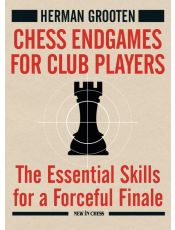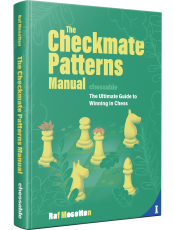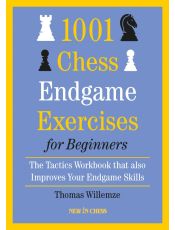Sadler on Books (2023#1)
These book reviews by Matthew Sadler were published in New In Chess magazine 2023#1
When I picked up 1001 Chess Endgame Exercises for Beginners by Thomas Willemze (New In Chess) I hadn’t actually noticed the ‘For Beginners’ part so I blinked a little bit at the title of the first chapter: ‘Mate in one move’. The title doesn’t quite cover the content of the book in my opinion. In principle, this book is tailor-made to teach beginners the elements of tactics starting with the simplest mates. It starts off with simple single-piece mate-in-ones delivered by the queen and then moves on to combination mates (for example rook and bishop pinning the opponent’s king to the back rank). Each mate is described in precise detail. One nice touch is how much attention Willemze pays to the role of the opponent’s own pawns and pieces in blocking escape squares for the king.
After mate-in-one, we move on to ‘win a piece in 2 moves’, then ‘mate in 2 moves’ and then ‘win a piece in 3 moves’.
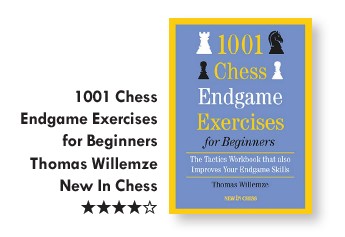
Just a small example to show you the complexity level you have reached by Chapter 4:
 1.♕b8+ ♔f7 2.♕a7+ ♔g6 3.♕xf2
1.♕b8+ ♔f7 2.♕a7+ ♔g6 3.♕xf2
The last two chapters are very neat too, looking at the opposite side of tactics: defence. There’s one chapter on defending your king and another on defending your pieces. The really nice part of it, however, is that since all these typical tactics are projected into endgame positions, the reader is improving both his or her appreciation of endgame play as well as tactics! I was really impressed by the structure and consistency of the material throughout the book. It’s definitely a book I would recommend to beginners looking for a way to improve their tactics and endgame play! 4 stars!
***
Maybe a next step-up after Thomas Willemze’s book would be Herman Grooten’s Chess Endgames for Club Players (New In Chess). It’s something in between a reference work for typical endgames and a practical guide for thinking about and approaching the endgame. For example, we have reference diagrams for how close a white king needs to be to the pawn for various queen vs pawn endgames to be winning, but the book also starts with a discussion of a very important practical topic which is too little addressed: the irrational fear that many players have of the endgame and the lengths to which they will go to avoid them. It’s essentially an endgame book that you can both study seriously and read with pleasure away from the board, and certainly nowadays, those are the types of books I like best!
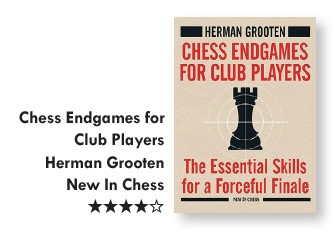
There was just one strange thing that caught my eye and it was this position that is presented in the preface.
 This is an adjourned position from a Dutch club match played long ago. Black is to move and White was awarded a win. However, the team of the Black player appealed, relying on an ‘insane’ defence, according to Grooten, which started with 1...♔f8. Grooten talks about how much time he and other strong players spent on it, without coming to a definite conclusion. I guess there must be something wrong with the diagram because it took me less than a minute to spot:
This is an adjourned position from a Dutch club match played long ago. Black is to move and White was awarded a win. However, the team of the Black player appealed, relying on an ‘insane’ defence, according to Grooten, which started with 1...♔f8. Grooten talks about how much time he and other strong players spent on it, without coming to a definite conclusion. I guess there must be something wrong with the diagram because it took me less than a minute to spot:
1...♖xe3
1...♔f8 2.♔f3 ♖b4 3.e4 h6 was the ‘insane’ defence the Black players found.
2.♖c7 ♖b3 3.b7 ♔f8 when 4.♖c8+ ♔e7 is fine for Black, as 5.b8♕ allows mate in 3 after 5...h5+ 6.gxh6 f5+ 7.♔g5 ♖g3 Mate.
I’d like to claim genius but I’m more or less sure that I’ve seen this before in another endgame book – it felt like déjà-vu when it flashed into my mind. I imagined that this line would appear somewhere later in the book, but unless I’m blind, I don’t see it!
That little quibble aside, there is much to admire and I would happily recommend this as a good reference book and inspiration for any club player looking to improve their endgames! 4 stars!
***
Finally, we have The Checkmate Patterns Manual by Raf Mesotten, which is another Chessable course turned into a beautiful hardback book. The author identifies 30 checkmate patterns and dedicates a chapter to each of them, presenting examples of varying degrees of difficulty.
A basic test at the start of the book checks your ability to solve a puzzle using each of those themes. If you fail to solve a puzzle in one theme, that’s good guidance for where you should start your studies. The book concludes with three large tests of increasing difficulty: a warming-up test, an advanced test and a final test. I ran through the basic test and a number of the chapters and I found it a very pleasurable and easy way to work at tactics. I’m quite envious when I think back to the books I worked through as a youngster: full of mistakes and incomplete or dubious solutions that sapped you very quickly of any desire to spend effort on them! This book would in fact be a very nice companion to Thomas Willemze’s book, as you see many similar ideas, but in positions with many more pieces on the board.
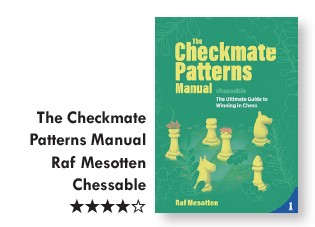
Let’s have an example of the level of difficulty of the exercises from the chapter on the ‘lawnmower mate’. If you haven’t heard this term before, you can maybe even guess what it looks like... and once you’ve seen it, you’ll never forget the name!
Arturs Neiksans - Hannes Stefansson
Liepaja 2004
 position after 24.gxf4
position after 24.gxf4
24...♖g6+
The white king is in serious trouble.
25.♔h1 ♕h3+ 26.♖h2 ♕xh2+ 27.♔xh2 ♔f7 0-1.
Lovely! ...♖h8+ with rapid mate is unstoppable!
A perfect tutor for club-players to test and hone their tactics! 4 stars!
